Carolina
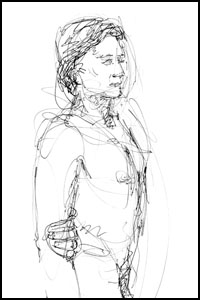 Dionisio
Dionisio
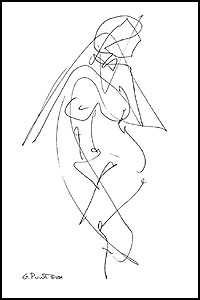 Francois
Francois
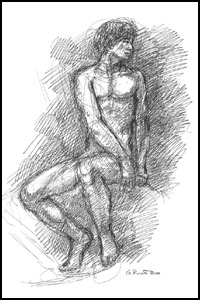
Male Nude
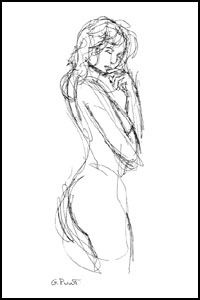
Female Nude

Walking

Female Nude 2.
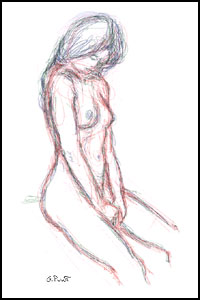
First Unveiling
|
|
Nine Months In Italy With Sculpture and
Drawing
By Gordon Punt, MFA
August 15, 1984 / August 30, 1984 - Blacksmith
Organize Nude Drawing Sessions
Two days ago I organized the first open
drawing session and held it in my studio. Many artists knew
about it but only three showed up: myself, Dionisio, and Carolina.
This included the model, since I have not been able to hire
one yet, so we each took turns posing in the nude. Other artists
like Francois would join us later on. It was fantastic and
a bit unusual because Dionisio still had a plaster cast on
his right foot from a motor-scooter accident. I was happy
with the drawings I did, considering I am out of practice,
and we plan to continue our sessions every week for many months
to come.
August 30, 1984
Visit to the Blacksmith for Stone Carving
Chisels
Today I had an interesting first visit to
one of the local blacksmiths who makes the chisels ("subie"),
that I need to use for stone carving. The first time I tried
to find his workshop I roamed around the hills for an hour
on the Vespa but the map I had was not clear, and was made
for walking up a one-way street, not for riding a vehicle,
since the Vespa was being repaired when the map was originally
made for me. Several days later I tried again, yesterday,
and took Marty, who is a painter friend of mine from Sonoma
County, and who is traveling around Europe for two months.
I checked out the map to make sure I was going the right way
this time and took off with the two of us on the Vespa. When
we got to the top of Via Cariona, where the street to the
small town of Torano was suppose to be, and where Nino the
blacksmith is, we met up with two "polizia" who
were giving surprise spot-checks of vehicles going by. One
of them waved us over while the other was checking someone's
car. He asked me for registration papers for the Vespa, which
there are none, but I told him my friend who owned the bike
had them. He then asked us for our papers, which I said were
in my studio, so we got out of that as well. But he told us
two people on the Vespa was illegal, and I think because we
were tourists and barely speaking Italian he did not give
us a ticket. To change the subject Marty asked them where
Torano was and they pointed back down the way we came, so
bewildered and a little shaken up we headed back down Via
Cariona into Carrara with Marty walking until we got around
a curve so he could jump back on. The police who stopped us
were more like state police and not local, the local police
do not care if you ride double on a motor scooter.
We went back to my studio, which is also off of Via Cariona
and finally found out the right directions to Torano so I
could make my way there the next day. In the morning I headed
out by myself, leaving Marty to carve on his first sculpture
piece, he being a painter. After departing my studio I realized
the hard earned map and information I was going to use was
in the pants-pocket I had just changed out of, but by now
I had enough information in my head so I continued on with
out it. In fifteen minutes I was in Torano and I soon found
Nino pounding away in his shop. Nino is a healthy slight man
in his sixties who works hard pounding hot metal every day.
He was busy as I entered the small black room, the stone walls
and floor stained with many years of coal and smoke. I told
him I wanted some chisels and after some awkward broken conversation
I realized he was going to make the fine "subie"
I wanted while I waited, after he finished what he was doing.
I also brought the chisel I had been using, which Nino made,
as an example, and which a friend gave me to use. Along with
this I brought two chisels that I bought at a local supply
store, of which both tips broke within fifteen minutes of
use! When they broke a friend gave me one of Nino's chisels
to try and to my amazement it stayed sharp and strong all
day. Before all of this I was using two carbide-tip chisels
which I was very happy with, but they became too short to
work with as I carved deeper into the marble block I was working
on, so I needed a longer shaft. I brought these along as well
so that Nino could grind down the mushrooming heads where
my hammer had been striking.
After fifteen minutes of waiting outside I heard the sound
of several metal bars which I know must be the ones for me.
Sure enough, as I stepped back into the cave I could see that
he was starting on my tools. I loved watching him work and
had a good idea what he was doing because I learned to make
my own chisels in a similar manner seven years ago. He was
an artist with the hot steel, heating, pounding, and dipping
in water or oil, like a painter would prepare a brush before
using. The bars were first heated over the flame and hot coals
to a bright orange on the end where I would eventually be
striking with the hammer. They were then pounded so that they
tapered in, so that my hammer blows would be concentrated
in the middle of the shaft, giving the point more power. After
shaping, the end was then submerged in cold water for maybe
three seconds to freak out the hot little molecules and cause
them to compact into a very hard but brittle composition.
If left in this brittle condition the metal would fracture
and chip off very quickly, so the process of tempering is
required. The example I am giving for preparing the striking
end of the chisel is similar to that of preparing the pointed
or sharp cutting end as well. For tempering; after the shaped
hot steel tip is dipped into water for a few seconds, the
heat from the center of the bar is allowed to travel back
into the tip. While this is happening, which is immediately,
a rainbow of color starts traveling from one inch back and
goes toward the tip, starting with a deep purple to blues,
green, reds, and finally a straw yellow. When the tip becomes
yellow it means that it is still very hard, but the steal
in back of it gradually gets softer, which will cushion the
blows from the sculptor's hammer, and keep it from breaking
off. At that crucial time when the last quarter-inch of the
tip is a straw yellow, the end is dipped into cold water again
to freeze it, and finally left standing in a quarter-inch
of oil, which does the final cooling in a slower manner than
the water, giving the tip more resilience. As I mentioned
earlier the cutting end is done similarly to the striking
end but the cutting end is more crucial and is given more
care, which also demands more experience to do successfully.
Since I left the map at home I did not remember Nino's name
and neither of us introduced ourselves, which did not matter.
While the steel was being heated in the flame, six inches
above was a large heavy pot also being heated. I thought this
was hot water for the tempering process or something, but
he eventually took the pot down, pored the water out, then
dumped four large chunks of meat on the black stone floor
close to where I was standing. One of them looked like the
heart of maybe a cow, and being a vegetarian, at the time,
I had to compose myself a little at the sight and smell, but
I just stepped aside a few feet and put my mind on the task
at hand. I also noticed that Nino was not using metal tongs
or gloves as he took the hot rods from the fire and handled
them. I asked him about that and he just smiled and showed
me his hands, which were black, calloused, and also tempered
from use.
Nino kept heating, pounding and shaping the "subie"
as we began to talk a little more and I felt comfortable in
trying out some of my fresh Italian words. He was pleased
to learn that I would be here for nine months, which all of
the locals are when I tell them. I then asked him which hammer
I should use for his chisels. Until I started working here
in Carrara I do not ever remember learning or hearing about
the use of different hammers, and I have been carving stone
for ten years! Though the weight differs according to the
individuals strength and purpose there are two basic types
of hammers: the soft metal, or "dolce" meaning sweet,
and the hard metal, or "duro" meaning hard or strong.
Chisels are also made two ways, which I did not know either.
At the end of one type of chisel, where the hammer strikes
it, there is a rim around the edge and a cavity in the center.
This type is used with the "dolce" (pronounced "dolche"),
hammer only, because if it is hit with the "duro"
hammer small pieces of the rim can break off like bullets
and hit the sculptor, or someone near by. The regular type
of chisel with a tapered flat striking end, like the ones
Nino was making for me, can be used with either the soft or
hard hammer. The reason for having a softer, so to speak,
type chisel and hammer is to help alleviate bruising the stone.
The stone is actually bruised every time the chisel point
is hit into it, and this is no problem until a sculptor decides
to polish that area. If the surface is left rough, like the
way I am working now, there is no reason to worry and the
harder chisel and hammer can be used to take off stone more
quickly. But if a surface is to be polished one has to be
careful that the blows from the chisel do not fracture the
material deeper than the level that is to be polished. If
this happens, then after the polishing is finished there will
be little dull white dots from a one-sixteenth to one-eighth
inch in diameter staring back at you, even though the surface
is perfectly smooth and shiny. This is hard to avoid, and
now that you know this secret you can look for them the next
time you back into a stone sculpture, whether it be your next
door neighbor's (who makes all that noise late at night),
or something you find in a museum.
Nino said I could use either hammer for the type of chisels
I wanted him to make. I had the hard type but also wanted
to try the soft "dulce', so I bought one from him, which
he made, including the rough carved wooden handle that he
forced into the iron head. Within one hour Nino had made the
five "subie" I ordered and repaired the other four
I brought with me. For all of this, including the hammer,
he only charged me about twelve dollars, plus everything is
guarantied! I thanked him and putted home with my new toys,
which I used immediately with great satisfaction.
............ ..<
Previous Journal..........
Journal Beginning>
|